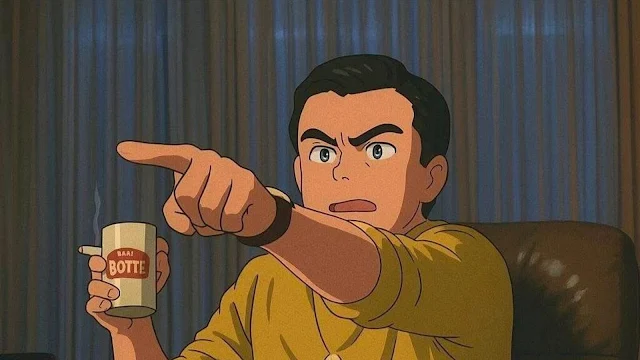A Little History
Studio Ghibli has always had a way of making the ordinary feel magical. In a fast-paced, digital world, its slow, immersive storytelling feels like a breath of fresh air. The studio, founded in 1985 by legendary filmmakers Hayao Miyazaki, Isao Takahata, and producer Toshio Suzuki, has shaped the world of animation in ways few could have imagined.
 |
| My Neighbor Totoro, 1988 |
With classics like My Neighbor Totoro, Spirited Away, and Howl’s Moving Castle, Ghibli introduced audiences to lush, hand-drawn landscapes and deeply human narratives. These films do more than entertain—they evoke emotion, nostalgia, and a sense of wonder. Over the decades, Ghibli’s distinctive art style has transcended cinema and become a cultural phenomenon.
The Rise of the Ghibli Aesthetic Online
The Debate: Is It Inspiration or Imitation?
There’s no denying Studio Ghibli’s influence. When a visual language becomes as iconic as Ghibli’s, it naturally finds its way into new creative expressions. Every art movement in history has been built on inspiration from those who came before. The same applies here. The real question isn’t whether AI should be involved in this evolution, but how we can build creative models that ensure artists benefit from their influence.
Instead of resisting trends like these, what if we looked at ways to innovate around them? Every viral movement is an opportunity—for artists, brands, and creators. Monetization, licensing, and collaborations should evolve with the landscape rather than fight against it. Just as fan art and adaptations have long been a part of creative culture, AI-generated styles can be a new frontier rather than a threat.
Trends Don’t Erase Originality—They Amplify It
The internet thrives on trends. But trends don’t destroy originality—they amplify it. When an aesthetic takes the digital world by storm, it reaches audiences who might never have discovered it otherwise. The real challenge is figuring out how to channel that reach into something sustainable for creators. Rather than rejecting AI tools outright, the focus should be on ethical use, proper credit, and fair monetization structures that support original artists.
Where Do We Go From Here?
There’s no easy answer to the question of AI in creative spaces. But one thing is certain—Ghibli’s impact isn’t fading anytime soon. Whether through AI, new animation techniques, or fresh storytelling approaches, its legacy will continue to inspire generations to come.
So, what’s your take? Should AI-generated trends be embraced or restricted? How can we strike a balance between innovation and artistic integrity? Let’s discuss.
#GhibliAesthetic #AIinArt #CreativeTrends #Leograph #trending







Comments
Post a Comment